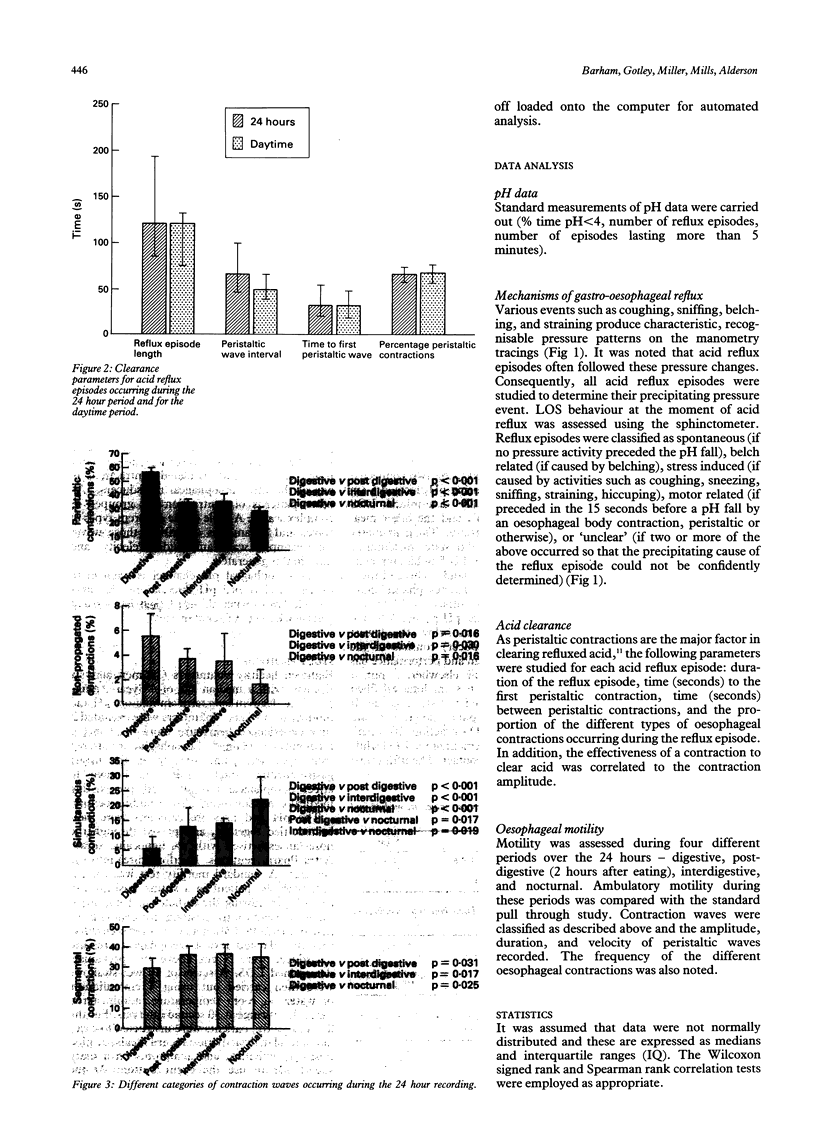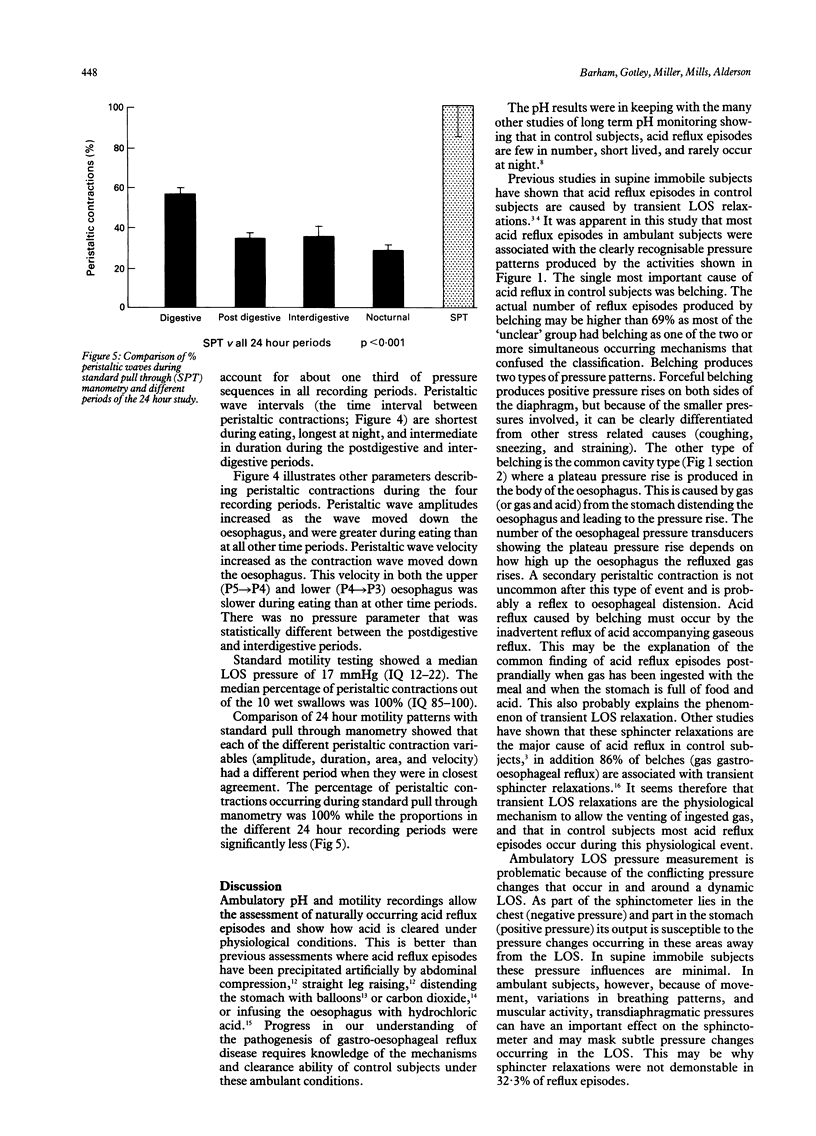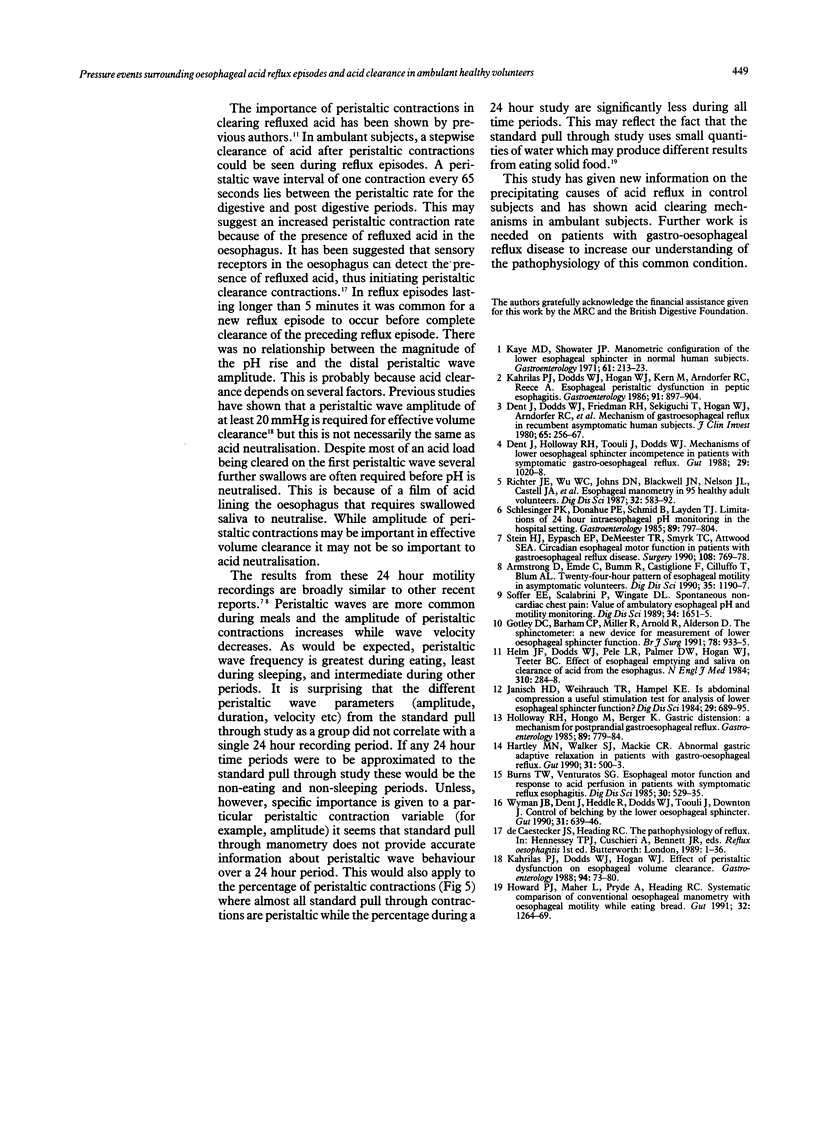Abstract
Previous studies of the mechanisms that precipitate acid reflux episodes and acid clearance have used unphysiological, short term hospital based data. A new 24 hour pH and motility recording system combined with computerised data analysis have been used to study naturally occurring acid reflux episodes in healthy ambulant volunteers. A variety of events that produced recognisable transdiaphragmatic pressure patterns were associated with acid reflux episodes (particularly belching). Peristaltic waves were the predominant contractions leading to oesophageal acid clearance and were the commonest contraction type during reflux episodes. Peristaltic wave parameters (amplitude, velocity, frequency, and percentage proportion) varied during different periods of the 24 hour recording. This study has produced new information about 24 hour oesophageal function and naturally occurring acid reflux which will provide a basis for comparison with patients with gastro-oesophageal reflux disease.
Full text
PDF





Selected References
These references are in PubMed. This may not be the complete list of references from this article.
- Armstrong D., Emde C., Bumm R., Castiglione F., Cilluffo T., Blum A. L. Twenty-four-hour pattern of esophageal motility in asymptomatic volunteers. Dig Dis Sci. 1990 Oct;35(10):1190–1197. doi: 10.1007/BF01536406. [DOI] [PubMed] [Google Scholar]
- Burns T. W., Venturatos S. G. Esophageal motor function and response to acid perfusion in patients with symptomatic reflux esophagitis. Dig Dis Sci. 1985 Jun;30(6):529–535. doi: 10.1007/BF01320258. [DOI] [PubMed] [Google Scholar]
- Dent J., Dodds W. J., Friedman R. H., Sekiguchi T., Hogan W. J., Arndorfer R. C., Petrie D. J. Mechanism of gastroesophageal reflux in recumbent asymptomatic human subjects. J Clin Invest. 1980 Feb;65(2):256–267. doi: 10.1172/JCI109667. [DOI] [PMC free article] [PubMed] [Google Scholar]
- Dent J., Holloway R. H., Toouli J., Dodds W. J. Mechanisms of lower oesophageal sphincter incompetence in patients with symptomatic gastrooesophageal reflux. Gut. 1988 Aug;29(8):1020–1028. doi: 10.1136/gut.29.8.1020. [DOI] [PMC free article] [PubMed] [Google Scholar]
- Gotley D. C., Barham C. P., Miller R., Arnold R., Alderson D. The sphinctometer: a new device for measurement of lower oesophageal sphincter function. Br J Surg. 1991 Aug;78(8):933–935. doi: 10.1002/bjs.1800780812. [DOI] [PubMed] [Google Scholar]
- Hartley M. N., Walker S. J., Mackie C. R. Abnormal gastric adaptive relaxation in patients with gastrooesophageal reflux. Gut. 1990 May;31(5):500–503. doi: 10.1136/gut.31.5.500. [DOI] [PMC free article] [PubMed] [Google Scholar]
- Helm J. F., Dodds W. J., Pelc L. R., Palmer D. W., Hogan W. J., Teeter B. C. Effect of esophageal emptying and saliva on clearance of acid from the esophagus. N Engl J Med. 1984 Feb 2;310(5):284–288. doi: 10.1056/NEJM198402023100503. [DOI] [PubMed] [Google Scholar]
- Holloway R. H., Hongo M., Berger K., McCallum R. W. Gastric distention: a mechanism for postprandial gastroesophageal reflux. Gastroenterology. 1985 Oct;89(4):779–784. doi: 10.1016/0016-5085(85)90572-4. [DOI] [PubMed] [Google Scholar]
- Howard P. J., Maher L., Pryde A., Heading R. C. Systematic comparison of conventional oesophageal manometry with oesophageal motility while eating bread. Gut. 1991 Nov;32(11):1264–1269. doi: 10.1136/gut.32.11.1264. [DOI] [PMC free article] [PubMed] [Google Scholar]
- Janisch H. D., Weihrauch T. R., Hampel K. E. Is abdominal compression a useful stimulation test for analysis of lower esophageal sphincter function? Dig Dis Sci. 1984 Aug;29(8):689–695. doi: 10.1007/BF01312939. [DOI] [PubMed] [Google Scholar]
- Kahrilas P. J., Dodds W. J., Hogan W. J. Effect of peristaltic dysfunction on esophageal volume clearance. Gastroenterology. 1988 Jan;94(1):73–80. doi: 10.1016/0016-5085(88)90612-9. [DOI] [PubMed] [Google Scholar]
- Kahrilas P. J., Dodds W. J., Hogan W. J., Kern M., Arndorfer R. C., Reece A. Esophageal peristaltic dysfunction in peptic esophagitis. Gastroenterology. 1986 Oct;91(4):897–904. doi: 10.1016/0016-5085(86)90692-x. [DOI] [PubMed] [Google Scholar]
- Kaye M. D., Showalter J. P. Manometric configuration of the lower esophageal sphincter in normal human subjects. Gastroenterology. 1971 Aug;61(2):213–223. [PubMed] [Google Scholar]
- Richter J. E., Wu W. C., Johns D. N., Blackwell J. N., Nelson J. L., 3rd, Castell J. A., Castell D. O. Esophageal manometry in 95 healthy adult volunteers. Variability of pressures with age and frequency of "abnormal" contractions. Dig Dis Sci. 1987 Jun;32(6):583–592. doi: 10.1007/BF01296157. [DOI] [PubMed] [Google Scholar]
- Schlesinger P. K., Donahue P. E., Schmid B., Layden T. J. Limitations of 24-hour intraesophageal pH monitoring in the hospital setting. Gastroenterology. 1985 Oct;89(4):797–804. doi: 10.1016/0016-5085(85)90575-x. [DOI] [PubMed] [Google Scholar]
- Soffer E. E., Scalabrini P., Wingate D. L. Spontaneous noncardiac chest pain: value of ambulatory esophageal pH and motility monitoring. Dig Dis Sci. 1989 Nov;34(11):1651–1655. doi: 10.1007/BF01540039. [DOI] [PubMed] [Google Scholar]
- Stein H. J., Eypasch E. P., DeMeester T. R., Smyrk T. C., Attwood S. E. Circadian esophageal motor function in patients with gastroesophageal reflux disease. Surgery. 1990 Oct;108(4):769–778. [PubMed] [Google Scholar]
- Wyman J. B., Dent J., Heddle R., Dodds W. J., Toouli J., Downton J. Control of belching by the lower oesophageal sphincter. Gut. 1990 Jun;31(6):639–646. doi: 10.1136/gut.31.6.639. [DOI] [PMC free article] [PubMed] [Google Scholar]


